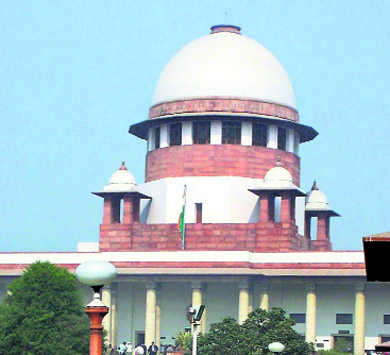
IT'S FINAL: The court also distinguishes between the ‘Collegium’ and powers of the CJ.
Sandeep Gopalan
The Supreme Court of India, on Friday, issued a landmark opinion underlining the powers of the Chief Justice as the master of the roster. This pragmatic and well-reasoned decision ought to put at rest the unsavoury controversy generated by a group of judges washing dirty linen in public and casting aspersions on how judicial panels are constituted. It should also help to re-establish the credibility of India’s judiciary.
The case arose from a petition filed by senior advocate Shanti Bhushan, claiming that the administrative function of assigning judges to particular cases must be performed by the Collegium and not the Chief Justice alone. The case should have been tossed aside at the outset because Bhushan ought to have no ‘standing’ to sue. However, the apex court has long dispensed with the standing doctrine to allow all manner of non-meritorious cases to be heard in the name of activism. And so, it was hoist on its own petard.
Bhushan’s claim boils down to an argument that ‘Chief Justice’ in the Supreme Court Rules, 2013, must be interpreted to mean ‘Collegium’ of the five seniormost judges. Perhaps in an implied admission of problems withstanding and justiciability of the claim, the court noted ‘at the outset that this matter has not been treated as adversarial in nature’. It is not clear how any court can hear such non-adversarial matters, except under a clearly demarcated advisory jurisdiction. But let’s leave that alone.
Turning to the controversy, the court relied extensively on a case called State of Rajasthan v. Prakash Chand (1998), in which the court had ruled that ‘the administrative control of the High Court vests in the Chief Justice alone’, although in terms of judicial functions, the Chief Justice ‘is only the first amongst the equals’. The Prakash Chand Bench held that the Chief Justice ‘is the master of the roster. He alone has the prerogative to constitute Benches of the court and allocate cases… [judges] can only do… work… [assigned] by the Chief Justice’.
This principle was affirmed in the subsequent case of Campaign for Judicial Accountability and Reforms v. Union of India (2018), where a five-judge panel held the Chief Justice ‘alone has the prerogative to constitute the Benches of the court and allocate cases to the Benches so constituted’. The court seemed to rely on common sense: ‘Unless such a position is clearly stated, there will be utter confusion.… [is] also the convention… the convention is followed because of the principles of law and because of judicial discipline and decorum’.
Similarly, in the Asok Pande case (2018), the court upheld ‘the exclusive duty and authority of the Chief Justice to constitute Benches and to allocate cases to them’.
The Supreme Court followed these precedents and Justice Sikri wrote that it was the Chief Justice’s ‘prerogative to constitute the Benches and allocate the subjects’ to them. Justice Sikri also elaborated on the role of the Chief Justice, given the Constitution’s silence on the position. He wrote that the Chief Justice had an administrative role including ‘moral responsibility’ to pursue ‘judicial reforms’ to provide access to justice. Such reforms included ‘procedural reforms and implementation’.
How does this square with the fact that it is the Collegium that is responsible for appointments and not the Chief Justice? The court distinguished the role of the Collegium explaining that it ‘was innovated by judicial interpretation in the context of appointment of judges in the constitutional courts’. It could not be ‘replicated when it comes to the role of the Chief Justice as Master of Roster’ because ‘it would be difficult to have smooth day-to-day functioning’ of the courts.
The court also made some parenthetical observations about the credibility of the judiciary, noting that ‘we live in an age of accountability’ and that judgments were increasingly being criticised. Notwithstanding these factors, the Chief Justice’s roster ‘power with wisdom has to be left to the Chief Justice’ who is given the prerogative of the ‘Master of the Roster’.
Justice Ashok Bhushan wrote a separate concurring opinion, noting that there was ‘no indication’ in the Constitution or rules ‘that for allocation of cases and formation of Benches, Chief Justice should be read as Collegium’.
The decision illustrates the perils of judicial activism — even the well-meaning kind. The court characterises the ‘Collegium’ as an innovation. However, the more appropriate label is that it is an invention born of judicial activism. Even assuming the intention was to protect judicial appointments from undue political interference, when courts stretch beyond the bounds of powers conferred by the text of the Constitution, they become vulnerable to making problematic mistakes. This is especially the case when activism essentially yields judicial legislation.
Unlike the legislature, the judiciary doesn’t possess the tools to amend and refine concepts to fit future contexts and anticipate developments based on policy goals — it can only decide the current dispute before it. Therefore, it is forced into awkward contortions — ‘Chief Justice’ means ‘Collegium’ in the context of appointments, but not in the context of roster. It is not clear that the rationale of practical constraints justifies the distinction. As we have seen with judicial appointments, the Collegium’s decisions are not immune from creating confusion or practical difficulties. So, why should the Chief Justice not be the master of appointments as well?
These awkward questions will remain unless the Supreme Court undertakes serious reforms to return to principles closely guarded by constitutional courts in other countries. These include an absolute fidelity to the ‘standing’ requirement (to weed out busybodies), adherence to stare decisis, judicial restraint, and due deference to the co-equal branches of the government. Until that time, India can at least celebrate this Supreme Court decision because it is based both on precedents and pragmatism.
A law professor at Deakin University



























